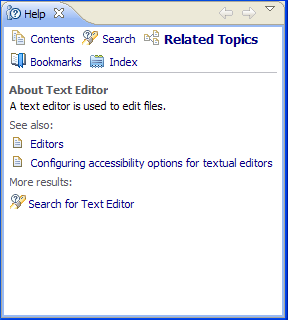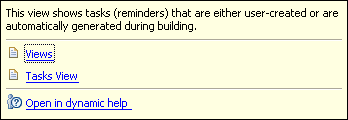
The Help system lets you browse, search, bookmark, and print help documentation. The documentation is organized into sets of information that are analogous to books. The help system also supplies a text search capability for finding the information you need by search phrase or keyword, and context-sensitive help for finding information to describe the particular function you are working with.
You can interact with help system in the workbench using the Help view or in the separate Help window. The view and window provide the same information but in different ways.
The Help view provides help inside the workbench. You can open the view from the main menu by selecting Help > Dynamic Help or Help > Search. The view will open showing the Related Topics or Search page, respectively. You can use links at the top of the help view to turn to other pages.
You can read more about the Help view and its various pages.

The Help window provides the same content as the Help view, but in a separate window instead of in a view. You can open the window from the main menu by selecting Help > Help Contents. The first view shown in the window is called Contents. This view displays the table of contents for the product documentation. Click on one of the links to expand the navigation tree for a set of documentation.

Note that if your browser does not have JavaScript enabled or is an does not support the features required to display the normal help application "basic" help which will be displayed - this can easily be identified because closed books in the table of contents do not have an expander icon. You can find the user agent of your browser here.
If you are working through a task and encounter a part of the interface that you do not understand, you can summon context-sensitive help. By default, this will display the Help view and give you some specific information about the view/editor/dialog you are using, and possibly some links to topics for further help.
Context-sensitive help can be accessed by bringing focus to the interface part
in question by clicking on it or using the Tab key, and then pressing
F1 (Shift+F1 on GTK+, and Help on the
Mac). Alternatively, in dialogs you can achieve the same result by pressing
the ![]() help button in the
dialog's button bar.
help button in the
dialog's button bar.
An alternative way of presenting context-sensitive information is using
infopops. You can use the
 Help preference page
to configure Help to use infopops instead of the Help view for displaying
context-sensitive help.
Help preference page
to configure Help to use infopops instead of the Help view for displaying
context-sensitive help.


Accessing help
Navigating help topics
Accessing context-sensitive help
Searching help